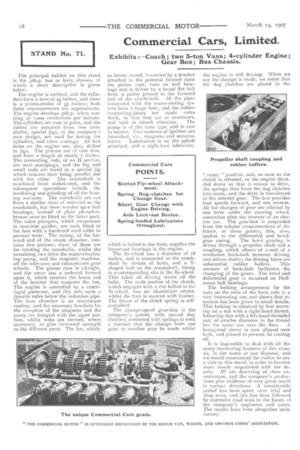Commercial Cars, Limited.
Page 16

If you've noticed an error in this article please click here to report it so we can fix it.
Exhibits :—Coach; two 5-ton Vans; 4-cylinder Engine ; Gear Box ; Bus Chassis.
The principal exhibit on this stand is the 30h.p. bus or lorry chassis, of which a short description is given below.
The engine is vertical, and the cylinders have a bore of 4 inches, and there is a piston-stroke of st inches; both these measurements are approximate. The engine develops 36h.p. when running at x,000 revolutions per minute. The cylinders are cast in pairs, and the valves are actuated from two camshafts; special jigs, of the company's own design, are used for boring the cylinders, and valve seatings. All bolt holes on the engine are, also, drilled in jigs. The pistons are of cast iron, and have a length of nearly 7 inches. The connecting rods, of an H section, are steel stampings, and the big and small ends are bored in a special jig which ensures their being parallel one with the other. The crankshaft is machined from nickel-steel, and the subsequent operations include the hardening and grinding of all the bearing surfaces. The camshafts are cut front a similar class of material as the crankshaft, but these revolve upon ball bearings, instead of plain phosphorbronze ones as fitted to the latter part. The valve plungers, which reciprocate in cast-iron guides, are each fitted at the foot with a hardened steel roller to prevent wear. The casing, at the forward end of the crank chamber, contains five pinions ; three of these are for rotating the camshafts, whilst the remaining two drive the water-circulating pump, and the magneto machine, off the inlet-cam and exhaust-cam gear wheels. The pinion case is cil-tight, and the cover has a pedestal formed upon it, which receives the lower end of the bracket that supports the fan. The engine is controlled by a centrifugal governor, and this acts upon a throttle valve below the induction pipe. The base chamber is an aluminium casting, and the necessary brackets for the reception of the magneto and the pump are integral with the upper portion, whilst webs are formed, where necessary, to give increased strength to the different parts. The fan, which,
as before stated, is carried by a bracket attached to the pedestal formed upon the pinion case, runs on ball bearings and is driven by a broad flat belt from a pulley pinned to the forward end of the crankshaft. :111 the pipes connected with the water-cooling systern have a large bare, and the rubber connecting-joints are made extra thick, so that they act as insulators, and tend to absorb vibration. The pump is of the vane type, and is cast in bronze. Two systems of ignition are furnished, viz., magneto and accumu• later;. Lubrication is on the splash principal, and a sight-feed lubricator, which is bolted to the dash, supplies the important bearings in the engine.
The fly-wheel has a diameter of IS inches, and is connected to the crankshaft by means of bolts, and a Tshaped web on the crankshaft, fitting in a corresponding slot in the fly-wheel. This takes all driving strain off the bolts. The male portion of the clutch, which engages with a rim bolted to the flv-wbeel, has an aluminium centre, whilst the face is covered with leather. The thrust of the clutch spring is self. contained.
The change-speed gear-box is the company's patent, with special dog clutches, combined with springs in such e manner that the change from one gear to another may be made whilst the engine is still driving. When we say the change is made, we mean that the dog clutches are placed in the " ready " position, and, as soon as the clutch is released, or the engine throttled down so that it ceases to drive, the springs then force the dog clutches into mesh, and the drive is transferred to the selected gear. The box provides four speeds forward, and one reverse. All the changes of gear are effected by one lever under the steering wheel, somewhat after the manner of an electric car. The gear-box is suspended from the tubular cross-members of the frame, at three points ; this, also, applies to the differential and bevel gear casing. The bevel gearing is driven through a propeller shaft and a coupling, which allows of I-16th of a revolution back-lash between driving and driven shafts ; the driving faces are substantial rubber buffers. This amount of back-lash facilitates the changing of the gears. The bevel and differential gear is mounted on Hoffmann hall bearings. The locking arrangement for the nuts on the ends of the back axle is a very interesting one and shows that attention has been given to small details. This locking is obtained by first screwing on a nut with a right-hand thread, following this with a left-hand threaded nut, of smaller diameter in the thread but the same size over the fiats. A hexagonal sleeve is now slipped over bath, and pinned to prevent its coming off.
It is impossible to deal with all the many interesting features of this chassis, in the space at our disposal, and we would recommend the visitor to pay a visit to this stand, in order to become more closely acquainted with the details. All are deserving of close examination, and the company's productions give evidence of very great merit in various directions. A considerable period has been spent over trial and shop tests, and this has been followed by extensive road tests in the hands of the company's engineers and users. The results have been altogether satisfactory.
































































